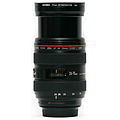Canon EF 24–70mm lens
 | |
| Maker | Canon |
|---|---|
| Technical data | |
| Type | Zoom |
| Focal length | 24-70mm |
| Crop factor | 1.0 |
| Aperture (max/min) | f/2.8 - f/22 |
| Close focus distance | 1.25ft / 380mm |
| Max. magnification | 0.29 (at 70mm) |
| Diaphragm blades | 8 |
| Construction | 16 elements in 13 groups |
| Features | |
| Short back focus | |
| Ultrasonic motor | |
| Lens-based stabilization | |
| Macro capable | |
| Application | Pro Standard Zoom |
| Physical | |
| Max. length | 4.9 in / 123.5 mm |
| Diameter | 3.3 in / 83.2 mm |
| Weight | 2.1lbs / 950g |
| Filter diameter | 77mm |
| Accessories | |
| Lens hood | EW-83F |
| Angle of view | |
| Horizontal | 74° – 29° |
| Vertical | 53° – 19°30' |
| Diagonal | 84° – 34° |
| History | |
| Introduction | November 2002 |
| Retail info | |
| MSRP | $1349.00 USD |
The EF 24-70mm f/2.8L is a professional EF mount wide-to-normal zoom lens. It was introduced by Canon in 2002 to replace the well-regarded 28-70mm f/2.8L.
Like its predecessor, this lens is often considered to have excellent contrast, color rendition and decent sharpness wide open [1]. However, some samples of this lens have also been reported to exhibit deficiencies and operational problems[2] not present in the older 28-70mm lens, including poor sharpness and/or chromatic aberration. Some reports suggest that the lens performs well only at certain apertures and focal lengths; others suggest that the lens back-focuses, primarily on DSLR cameras[citation needed]. The disparity between positive and negative reports about this lens indicates both manufacturing inconsistencies and subtle camera compatibility issues, as well as potential user error and misinterpretation of results by amateur photographers using professional equipment[citation needed].
The lens includes sealing against dust and water, although it is not waterproof. It also includes an 8-bladed curved diaphragm which remains nearly circular from f/2.8 to f/5.6. Characteristic of zoom lenses, it exhibits some barrel distortion at its shortest focal length.
Reverse zoom
An unusual aspect of the 24-70mm f/2.8L (and 28-70mm f/2.8L) is that its barrel extends as it zooms toward its shortest focal length. When used with the supplied lens hood, which attaches to a non-moving part of the lens, this extension results in a properly matched shade at every angle of view. Most zoom lens hoods are designed for only the widest angle of view, offering progressively inadequate shade at longer focal lengths.
This reverse zoom is illustrated with the following two pictures:
-
Lens at 24 mm with a UV filter
-
Lens at 70 mm with a UV filter
At the telephoto end (70 mm) the end of the lens is the most retracted providing the most shade protection from the lens hood. At the widest end (24 mm) the end of the lens is the most protruding providing the least shade protection from the lens hood.
Macro
This lens is not a true macro lens, as it has a maximum magnification of only 0.29x (1:3.5) and not 1x (1:1).
See also
- Canon EF 28-70mm lens was the lens replaced by the 24-70mm
- Canon EF 24-105mm lens an L class lens with a similar but longer focal length. The main difference is a slower F4.0 aperture but the addition of image stabilisation.
- Canon EF 70-200mm lens has the same maximum aperture of 2.8 and continues the 24-70's maximum focal length through 200 mm
References
External links
Gallery
-
EF 24-70 f2.8L lens mounted on a Canon EOS 5D Mark II



